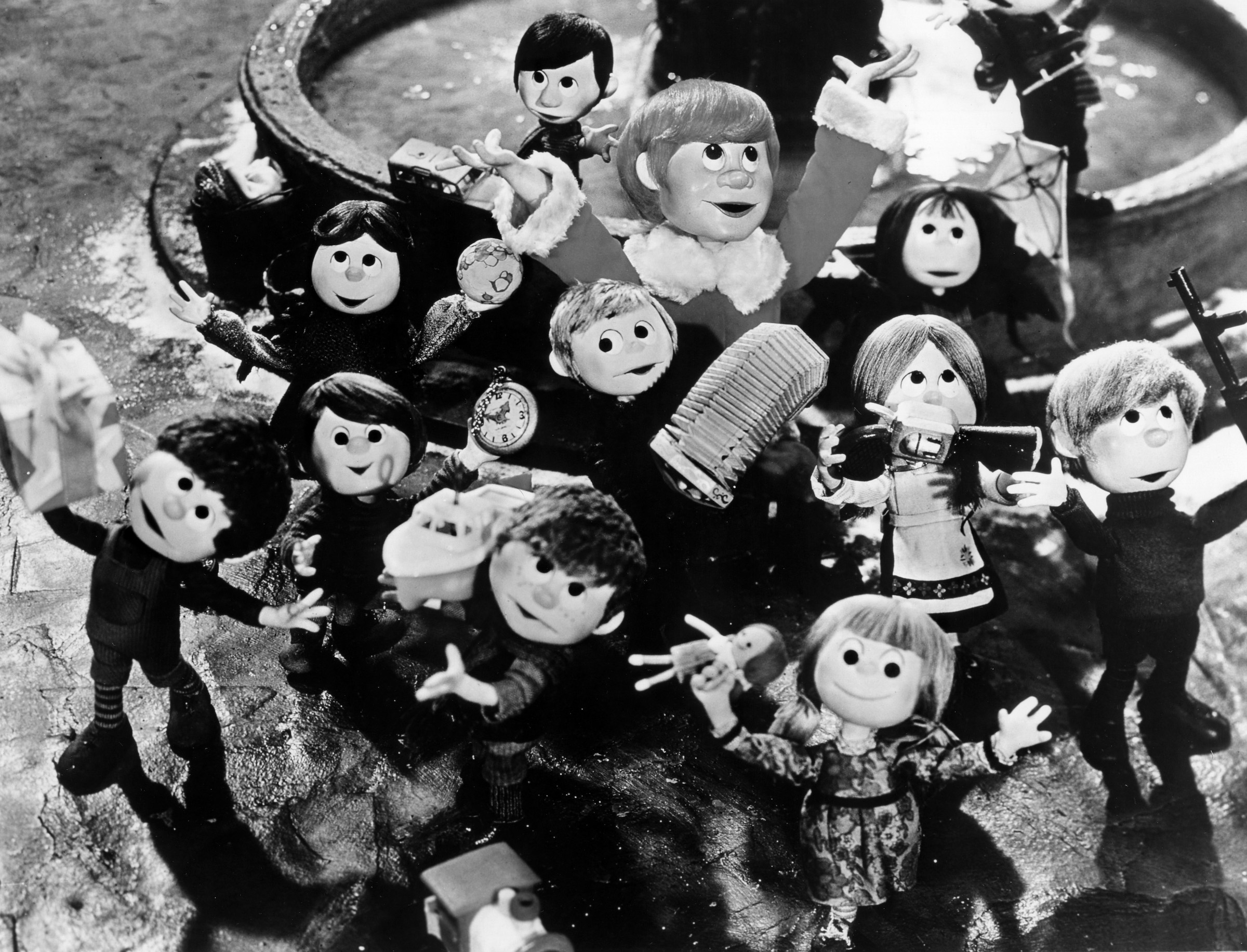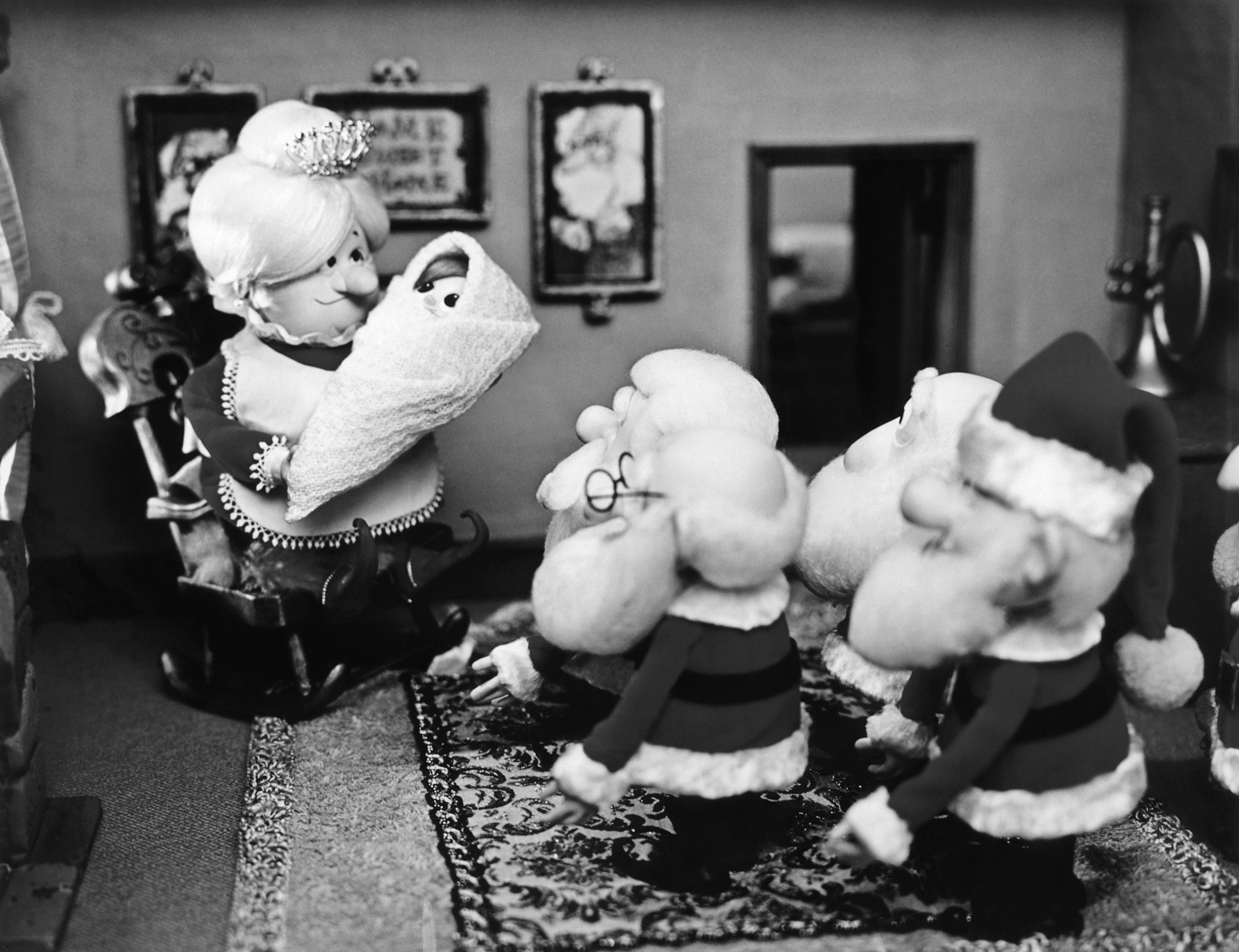
Marching through somber streets, men in uniform confiscate items, entering houses for further looting, all legalized by a leader waving his fist and spewing anger. Germany in the 1930s? No, the classic Christmas movie Santa Claus is Comin’ to Town, which aired originally in 1970.
Written and directed by the men who brought Americans Rudolph the Red-nosed Reindeer, Frosty the Snowman, and the Little Drummer Boy, Santa Claus is Comin’ to Town was a classic story of good versus evil. It used Nazi imagery and symbolism to craft an origin story for Santa Claus—the story’s hero and the pinnacle figure of capitalist, secular Christmas. Needing an antihero for Santa to thwart, the film capitalized on a decade in which news stories, early Holocaust scholarship, and representations in popular culture made Americans far more aware of the Nazis and their heinous crimes. Many Americans have watched it almost every year since.
Yet, while the story is beloved, it points to a cultural problem that has helped perpetuate antisemitism. The movie reminds Christian Americans of the Nazi crimes and uses them to convey villainy, without engaging antisemitism or Jewish people at all. Christmas presents, not Jewish people, are the victims of the vaguely German antihero. This is a common practice in movies, television, and novels, and it has left Americans understanding the evil of the Nazis without fully grasping who they targeted, why, and how the antisemitism at the root of the Holocaust continues to reverberate for Jewish communities around the world.
Despite early efforts after World War II to punish the Nazis, such as the Nuremberg Trials, as well as the creation of the state of Israel, collective memory of the era failed to grasp fully the horrors of the genocide perpetrated against Jewish people. One problem was that some audiences Christianized the victims to be able to empathize and identify with the tragedy.
In the 1950s, the reaction to the best-selling The Diary of a Young Girl epitomized how popular memory of the Holocaust was incomplete, with the public not reckoning with the full scope of the Nazi atrocities — especially who the victims were and why they were targeted. Readers tended to ignore Anne Frank’s Jewishness, viewing her as Anglicized and as forgiving them: “In spite of everything, I still believe that people are really good at heart,” Frank wrote before having seen a death camp.
Read More: Inside the Biden Administration's Response to the Spike in Antisemitic Attacks
A turning point arrived in 1960, when Israel captured Nazi leader Adolf Eichmann in Argentina, and flew him to Jerusalem to stand trial. Survivors provided eyewitness testimony, including photographs, and the world rediscovered the tragedy. Planes air-shipped video-tapes of the proceedings to New York every day to ensure that the American media covered the trial.
That year also marked the translation of Night by Eli Wiesel from Yiddish into English. The book offered a depiction of a ghetto, a deportation, a death camp, and a death march, from the perspective of a Jewish survivor with an instinct for literary framing. Night became a mainstay of literature and history curricula. Historical memory of Nazi Germany and the Holocaust were on the rise.
Even so, Wiesel’s book revealed how Holocaust memory was often tailored to the interests of Christian audiences. He emphasized his struggles with faith, which helped to connect with Christian audiences for whom belief in God is a central theological question.
In 1965, the award-winning film The Sound of Music also reflected how, even as the Nazis' crimes had become more visible, Holocaust memory often excluded the tie between antisemitism and the Nazi regime. Sometimes, Jewish victims themselves were missing entirely, as was the case in The Sound of Music, which featured Nazi villains without ever depicting or even mentioning Jewish people.
The rise in consciousness meant that when the filmmakers behind Santa Claus is Comin’ to Town needed an antagonist and a backdrop to convey evil, the Nazi trope was well known among Americans. They knew it would work to feature an evil bad guy with a German-sounding name — Burgermeister Meisterburger — and a German-accented voice.
The inciting incident in the movie occurs when Meisterburger, the Mayor of “Sombertown,” trips on a toy and breaks his “funny bone.” “I hate toys,” he declares, “and toys hate me. Either they are going, or I am going, and I am certainly not going.” He growls to his right-hand man, Grimsley, “Take this down.”
He breaks into song, proclaiming, “Let it be known throughout the land from sea to sea / there will be no more toymakers.” He delivers the melody with an air of authority, with Meisterburger's grimacing voice carrying a catchy tune while proclaiming violence against all toys: “Outlaw the dolls and sink the boats / they bring me only woes.” Grimsley transcribes Meisterburger's whims and issues a formal decree: “Toys are hereby declared illegal, immoral, unlawful, and anyone found with a toy in his possession will be placed under arrest and thrown in the dungeon.”
To make Meisterburger and his regime sufficiently sinister, the filmmakers had them resort to tactics that mimic some of what the Nazis did. The anti-toy decree functions in Sombertown like the 1935 Nuremberg Laws did in Germany. Empowered by the law, men in uniform patrol the streets, confiscating possessions and instilling fear among townspeople. At one point they even publicly burn toys.
Crucially, the film replaced Jews with toys. Rather than depriving Jewish people of the rights, privileges, and physical safety of citizenship as happened in Germany, Burgermeister banned the people of Sombertown from having toys. “If you find so much as a marble or half a jack, the whole house is under arrest,” he ordered, searching each home before dawn with armed men in tow.
Read More: Ken Burns on His New Documentary 'The U.S. and the Holocaust'
That’s the backdrop against which Santa Claus a.k.a. Kris Kringle sneaks into houses by night to hide toys and circumvent the authoritarian, oppressive regime. Kringle’s team — a penguin, a winter warlock, and the future Mrs. Claus — and the townspeople brave and spirited enough to challenge authority join him in hiding toys. Just as people in Nazi Germany hid Jews, to protect lives, Kringle and his allies hide toys, to protect, presumably, Christmas.

Yet, once again, as with the Sound of Music, Santa Claus is Comin’ to Town uses the Nazis as villains while decoupling them from their primary victims: Jewish people. In this case, the goal was to elevate Christmas and advance the secular, cultural aspects of the holiday. After all, Santa Claus is Comin’ to Town was not a Holocaust movie and never claimed to be.

But the choice reflected the way in which Nazis had come to play a key role as a villain in American collective consciousness without widespread understanding of the antisemitism at the root of their crimes. Fighting Nazi-reminiscent monsters has become a common plot element in all sorts of movies, books, and more.
Nothing’s wrong with using a historically horrific regime and their evil as inspiration for fictional bad guys. In fact, it makes sense, because it conveys to the audience how uniquely evil the antagonist is. But the tradition of doing so with the Nazis has left viewers unaware of the history of antisemitism, how the Holocaust looks from a Jewish perspective, and how that understanding shapes Jewish fears in 2023. When Jewish people sound the alarm about the rise of antisemitism, many downplay it. They don’t grasp the historical memory shaping Jewish perceptions.
Santa Claus is Comin’ to Town is a classic: the plot is catchy, the music is memorable, and the characters are iconic. It also premiered at a formative moment for Holocaust memory in the U.S. When retreating to the nostalgia of a mid-20th century classic, viewers should enjoy it while also considering who’s included, who’s erased, and how those choices shape the present.
Rebecca Brenner Graham is a history teacher at the Madeira School, an adjunct professorial lecturer at American University, and a Cokie Roberts fellow at the National Archives. Her forthcoming book, Dear Miss Perkins: A Story of Frances Perkins's Efforts to Aid Refugees from Nazi Germany, will be published by Kensington in 2025. Made by History takes readers beyond the headlines with articles written and edited by professional historians. Learn more about Made by History at TIME here.
More Must-Reads from TIME
- Inside Elon Musk’s War on Washington
- Why Do More Young Adults Have Cancer?
- Colman Domingo Leads With Radical Love
- 11 New Books to Read in February
- How to Get Better at Doing Things Alone
- Cecily Strong on Goober the Clown
- Column: The Rise of America’s Broligarchy
- Introducing the 2025 Closers
Write to Rebecca Brenner Graham / Made by History at madebyhistory@time.com
